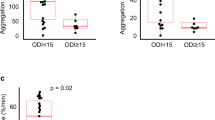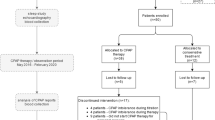Abstract
Patients with obstructive sleep apnea (OSA) are at increased risk of atherothrombosis independent of the Framingham risk factors. Studies on hemostasis factors in OSA are scarce and inconsistent. We sought to understand the variation in atherothrombotic propensity as a function of apoptotic circulating endothelial cells (CECs) in OSA by investigating the relationship between CEC apoptosis and plasma levels of hemostatic factors tissue factor (TF) and von Willebrand Factor (vWF) in apneic subjects. Apoptotic CECs were detected by flow cytometry in 35 male subjects free of cardiovascular diseases (AHI range 8–43) and 12 healthy male controls (AHI range 2–5) before and after 8 weeks of nasal continuous positive airway pressure (nCPAP). Quantitative determination of TF and vWF was performed using an enzyme-linked immunosorbent assay (ELISA) kit. The mean levels of TF (66.78 ± 41.59 pg/ml) and vWF (189.70 ± 69.24 IU/dl) were significantly higher in OSA patients compared with those in healthy subjects (42.83 ± 14.18 pg/ml; and 124.48 ± 31.43 IU/dl). Apoptotic CECs were elevated in patients with OSA and correlated strongly with TF and vWF levels (p = 0.02 and p < 0.001; respectively). There were no correlations between TF, vWF and apnea hypopnea index, or arousal index. Only the percentage of time spent <90% oxygen saturation was inversely associated with TF (r = 0.38; p = 0.02). Following nCPAP therapy, there was significant decrease in TF levels that correlated with decrease in apoptotic CECs. In patients with OSA, increased prothrombotic factors are strongly determined by apoptotic CECs. Treatment with nCPAP may alleviate the coagulation propensity.



Similar content being viewed by others
References
Young T, Peppard PE, Gottlieb DJ (2002) Epidemiology of obstructive sleep apnea: a population health perspective. Am J Respir Crit Care Med 165:1217–1239
Nieto FJ, Young TB, Lind BK, Shahar E, Samet JM, Redline S, D'Agostino RB, Newman AB, Lebowitz MD, Pickering TG (2000) Association of sleep-disordered breathing, sleep apnea, and hypertension in a large community-based study. Sleep Heart Health Study. JAMA 283:1829–1836
Peppard PE, Young T, Palta M, Skatrud J (2000) Prospective study of the association between sleep disordered breathing and hypertension. N Engl J Med 342:1378–1384
Punjabi NM, Sorkin JD, Katzel LI, Goldberg AP, Schwartz AR, Smith PL (2002) Sleep-disordered breathing and insulin resistance in middle-aged and overweight men. Am J Respir Crit Care Med 165:677–682
Punjabi NM, Ahmed MM, Polotsky VY, Beamer BA, O’Donnell CP (2003) Sleep-disordered breathing, glucose intolerance, and insulin resistance. Respir Physiol Neurobiol 136:167–178
Bokinsky G, Miller M, Ault K, Husband P, Mitchell J (1995) Spontaneous platelet activation and aggregation during obstructive sleep apnea and its response to therapy with nasal continuous positive airway pressure: a preliminary investigation. Chest 108:625–630
Eisensehr I, Ehrenberg BL, Noachtar S et al (1998) Platelet activation, epinephrine, and blood pressure in obstructive sleep apnea syndrome. Neurology 51:188–195
Rangemark C, Hedner JA, Carlson JT, Korbett K, Byrne A, McAuley A, Palabrica T (1995) Platelet function and fibrinolytic activity in hypertensive and normotensive sleep apnea patients. Sleep 18:188–194
von Känel R, Le DT, Nelesen RA, Mills PJ, Ancoli-Israel S, Dimsdale JE (2001) The hypercoagulable state in sleep apnea is related to comorbid hypertension. J Hypertens 19:1445–1451
El Solh A, Akinnusi M, Baddoura F, Mankowski C (2007) Endothelial apoptosis in obstructive sleep apnea. Am J Respir Crit Care Med 175:1186–1191
Combes V, Simon A, Grau G, Arnoux D, Camoin L, Sabatier F, Mutin M, Sanmarco M, Sampol J, Dignat-George F (1999) In vitro generation of endothelial microparticles and possible prothrombotic activity in patients with lupus anticoagulant. J Clin Invest 104:93–102
Boneu B, Abbal M, Plante J, Bierme R (1975) Factor-VIII complex and endothelial damage. Lancet 1:1430
Blann A, McCollum C, Lip G (2002) Relationship between plasma markers of endothelial cell integrity and the Framingham cardiovascular disease risk-factor scores in apparently healthy individuals. Blood Coagul Fibrinolysis 13:513–518
Johns MW (1991) A new method for measuring daytime sleepiness: the Epworth Sleepiness Scale. Sleep 14:540–545
Rechtschaffen A, Kales A (1968) Manual of standardized terminology, techniques and scoring system for sleep stages of human subjects. US Government Printing Office, Washington, DC
El Solh A (2007) Role of CD146 in detection of apoptotic circulating endothelial cells in obstructive sleep apnea. Am J Respir Crit Care Med 175:1347
Rajagopalan S, Somers E, Brook R, Kehrer C, Pfenninger D, Lewis E, Chakrabarti A, Richardson BC, Shelden E, McCune WJ, Kaplan MJ (2004) Endothelial apoptosis in systemic lupus erythematosus: a common pathway for abnormal vascular function and thrombosis propensity. Blood 103:3677–3683
Wessendorf T, Thilmann A, Wang Y, Schreiber A, Konietzko N, Teschler H (2000) Fibrinogen levels and obstructive sleep apnea in ischemic stroke. Am J Respir Crit Care Med 162:2039–2042
Robinson GV, Pepperell JC, Segal HC, Davies R, Stradling J (2004) Circulating cardiovascular risk factors in obstructive sleep apnoea: data from randomized clinical trials. Thorax 59:777–782
Soejima H, Ogawa H, Yasue H, Kaikita K, Nishiyama K, Misumi K, Takazoe K, Miyao Y, Yoshimura M, Kugiyama K, Nakamura S, Tsuji I, Kumeda K (1999) Heightened Tissue Factor Associated With Tissue Factor Pathway Inhibitor and Prognosis in Patients With Unstable Angina. Circulation 99:2908–2913
Campo G, Valgimigli M, Ferraresi P, Malagutti P, Baroni M, Arcozzi C, Gemmati D, Percoco G, Parrinello G, Ferrari R, Bernardi F (2006) Tissue Factor and Coagulation Factor VII Levels During Acute Myocardial Infarction: Association With Genotype and Adverse Events. Arterioscler Thromb Vasc Biol 26:2800–2806
Morange PE, Simon C, Alessi M, Luc G, Arveiler D, Ferrieres J, Amouyel P, Evans A, Ducimetiere P, Juhan-Vague I, on behalf of the PRIME Study Group (2004) Endothelial Cell Markers and the Risk of Coronary Heart Disease. The Prospective Epidemiological Study of Myocardial Infarction (PRIME) Study. Circulation 109:1343–1348
Hayashi M, Fujimoto K, Urushibata K, Takamizawa A, Kinoshita O, Kubo K (2006) Hypoxia-sensitive molecules may modulate the development of atherosclerosis in sleep apnoea syndrome. Respirology 11:24–31
Von Känel R, Loredo J, Ancoli-Israel S, Dimsdale J (2006) Association between sleep apnea severity and blood coagulability: treatment effects of nasal continuous positive airway pressure. Sleep Breath 10:139–146
Waltenberger J, Mayr U, Pentz S, Hombach V (1996) Functional upregulation of the vascular endothelial growth factor receptor KDR by hypoxia. Circulation 94:1647–1654
Zhan G, Fenik P, Pratico D, Veasey S (2005) Inducible nitric oxide synthase in long-term intermittent hypoxia. Am J Respir Crit Care Med 171:1414–1420
Yan S, Zou Y, Gao Y, Zhai C, Mackman N, Lee S, Milbrandt J, Pinsky D, Kisiel W, Stern D (1998) Tissue factor transcription driven by Egr-1 is a critical mechanism of murine pulmonary fibrin deposition in hypoxia. Proc Natl Acad Sci USA 95:8298–8303
Von Känel R, Loredo J, Ancoli-Israel S, Mills P, Natarajan L, Dimsdale J (2007) Association between polysomnographic measures of disrupted sleep and prothrombotic factors. Chest 131:733–739
Schultz R, Mahmoudi S, Hattar K, Sibelius U, Olschewski H, Mayer K, Seeger W, Grimminger F (2000) Enhanced release of superoxide from polymorphonuclear neutrophils in obstructive sleep apnea: impact of continuous positive airway pressure therapy. Am J Respir Crit Care Med 162:566–570
Schulz R, Seeger W, Grimminger F (2001) Serum nitrite/nitrate levels in obstructive sleep apnea. Am J Respir Crit Care Med 164:1997–1998
Liu H, Liu J, Xiong S, Shen G, Zhang Z, Xu Y (2000) The change of interleukin-6 and tumor necrosis factor in patients with obstructive sleep apnea syndrome. J Tongji Med Univ 20:200–202
Harada-Shiba M, Kinoshita M, Kamido H, Shimokado K (1998) Oxidized low density lipoprotein induces apoptosis in cultured human umbilical vein endothelial cells by common and unique mechanisms. J Biol Chem 273:9681–9687
Tedgui A, Mallat Z (2001) Apoptosis is a determinant of atherothrombosis. Thromb Haemost 86:420–426
Bombeli T, Karsan A, Tait J, Harlan J (1997) Apoptotic vascular endothelial cells become procoagulant. Blood 89:2429–2442
Vischer VM, Wollheim CB (1998) Purine nucleotides induce regulated secretion of von Willebrand factor: involvement of cytosolic Ca2+ and cyclic adenosine monophosphate-dependent signaling in endothelial exocytosis. Blood 91:118–127
Acknowledgements
We wish to thank Dr. Fadi Baddoura for collaboration and Debra Zelinski for secretarial assistance. The study was supported by a grant from the Research Foundation for Health in Erie County.
Author information
Authors and Affiliations
Corresponding author
Rights and permissions
About this article
Cite this article
El Solh, A.A., Akinnusi, M.E., Berim, I.G. et al. Hemostatic implications of endothelial cell apoptosis in obstructive sleep apnea. Sleep Breath 12, 331–337 (2008). https://doi.org/10.1007/s11325-008-0182-x
Received:
Accepted:
Published:
Issue Date:
DOI: https://doi.org/10.1007/s11325-008-0182-x




